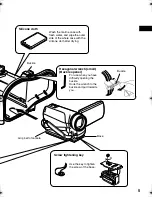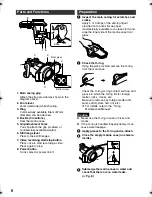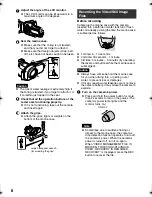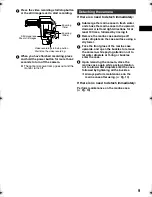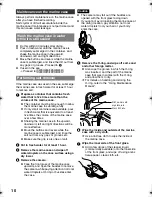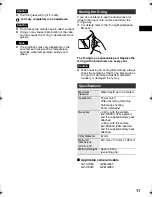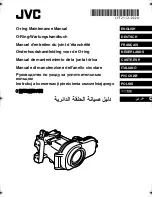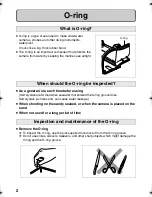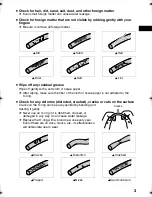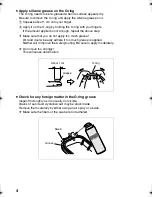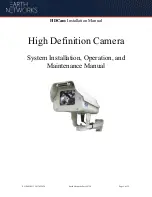
LYT2112-003A
0509MNH-SW-OT
水中撮影時のフロントガラスのくもりを防ぐために
以下のような状態で水中撮影を行うと、フロントガラスにくもりが生じ、撮影画像に支障をきたす恐れがあります。ご使用の際
は、注意してください。
1. マリンケース内部の水分について
マリンケース内部にわずかでも水分が残っている状態で水中撮影を行うと、くもりが発生することがあります。ご使用の前
に、マリンケース内部が十分に乾いていることを確認してください。
マリンケース開閉時およびビデオカメラ装着時は、水分が入らないように十分にご注意ください。特に、濡れた手で触った
ビデオカメラをそのまま装着することは避けてください。
2. ビデオカメラ装着時の温度・湿度
高温・多湿の場所でビデオカメラを装着すると、その後の水中撮影でくもりが発生することがあります。装着や装着後の保
管は、できるだけ低い温度・湿度の場所で行なってください。
3. 撮影時の温度差
炎天下の船上に放置するなど、高温にさらされた状態から水中撮影を行うと、その温度差でくもりが発生することがありま
す。水中撮影を行うときは、できるだけ温度差を少なくしてから撮影してください。
4. 急激な水圧変化による影響
水深が深い所に急に潜水すると、急激な圧力変化でくもりが発生することがあります。潜水時には緩やかに深度をとること
をおすすめします。
Preventing fogging of the front glass during underwater shooting
Performing underwater shooting under the following conditions may cause the front glass to fog, thus affecting the quality of the
images taken. Take note of the following precautions during use.
1.
Moisture inside marine case
A slight amount of moisture inside the marine case may cause fogging during underwater shooting. Make sure that the interior
of the marine case is completely dry before use.
Pay careful attention not to allow water to enter the case when opening/closing the marine case or when mounting the camera.
In particular, do not mount the camera if it has been touched by wet hands.
2.
Temperature and humidity during camera mounting
Fogging may occur during underwater shooting if the camera is mounted at a location that has a high temperature or humidity
level. Mount the camera or store the camera after mounting at a location with a low temperature and humidity level.
3.
Temperature difference during shooting
If the camera is left under a high temperature, such as under the hot sun on the boat, immediately prior to underwater shooting,
fogging may occur due to the large temperature difference. Minimize the temperature difference as much as possible before
shooting underwater.
4.
Drastic change in water pressure
If you dive suddenly into deep water, the drastic change in water pressure may cause fogging to occur. It is recommended that
you move gradually into deep water during diving.
So verhindern Sie, dass sich das Frontglas bei Unterwasseraufnahmen beschlägt
Unterwasseraufnahmen unter folgenden Bedingungen können dazu führen, dass sich das Frontglas beschlägt, was die
Aufnahmequalität beeinträchtigt. Folgen Sie deshalb diesen Vorsichtsmaßnahmen.
1.
Feuchtigkeit im Unterwassergehäuse
Eine geringe Feuchtigkeitsmenge im Unterwassergehäuse kann bei Unterwasseraufnahmen ein Beschlagen verursachen.
Vergewissern Sie sich vor der Verwendung, dass das Innere des Unterwassergehäuses völlig trocken ist.
Lassen Sie auf keinen Fall beim Öffnen/Schließen des Unterwassergehäuses oder beim Einsetzen der Kamera Wasser
eindringen. Setzen Sie vor allem die Kamera nicht ein, wenn diese mit nassen Händen berührt wurde.
2.
Temperatur und Luftfeuchtigkeit beim Einsetzen der Kamera
Wenn die Kamera an einem Ort mit hoher Temperatur oder Luftfeuchtigkeit eingesetzt wurde, kann bei
Unterwasseraufnahmen ein Beschlagen auftreten. Setzten Sie die Kamera an einem Ort mit niedriger Temperatur und
Luftfeuchtigkeit, bzw. lagern Sie sie dort nach dem Einsetzen.
3.
Temperaturunterschiede während der Aufnahme
Wenn die Kamera unmittelbar vor der Unterwasseraufnahme hoher Temperatur ausgesetzt wird, wie etwa bei greller Sonne im
Boot, kann es aufgrund des großen Temperaturunterschieds zu einem Beschlagen kommen. Halten Sie den
Temperaturunterschied vor der Unterwasseraufnahme möglichst gering.
4.
Starke Änderungen im Wasserdruck
Wenn Sie plötzlich in tiefes Wasser tauchen, kann die starke Änderung im Wasserdruck ein Beschlagen hervorrufen. Es wird
empfohlen, beim Tauchen allmählich in tieferes Wasser vorzudringen.
日本語
ENGLISH
DEUTSCH
Prévenir la formation de buée dans le hublot avant lors de la prise de photos sous l’eau
Prendre des photos sous l’eau dans les conditions suivantes peut causer la formation de buée dans le hublot avant, ce qui pourrait
nuire à la qualité des images prises. Prenez note des précautions suivantes lors de l’utilisation.
1.
Humidité à l’intérieur du boîtier sous-marin
Un peu d’humidité dans le boîtier sous-marin peut causer la formation de buée pendant la prise de photos sous l’eau. Assurez-
vous que l’intérieur du boîtier sous-marin soit complètement sec avant l’utilisation.
Faites très attention de ne pas laisser d’eau s’infiltrer dans le boîtier au moment d’ouvrir ou de fermer le boîtier sous-marin ou lors du
montage de l’appareil photo. Ne montez surtout pas l’appareil photo s’il a été manipulé par une personne avec les mains mouillées.
2.
Température et humidité au moment du montage de l’appareil photo
La formation de buée peut se produire pendant la prise de photos sous l’eau si l’appareil photo est monté à un endroit où la
température ou le niveau d’humidité sont élevés. Montez l’appareil photo ou entreposez-le après le montage à un endroit où la
température et le niveau d’humidité sont peu élevés.
3.
Différence de température lors de la prise de photos
Si l’appareil photo est soumis à une température élevée, comme à un soleil chaud sur un bateau, immédiatement avant la prise
de photos sous l’eau, la formation de buée peut avoir lieu en raison de l’importante différence de température. Minimisez la
différence de température le plus possible avant de prendre des photos sous l’eau.
4.
Variation draconienne de la pression de l’eau
Si vous plongez soudainement dans une eau très profonde, la variation draconienne de la pression de l’eau peut causer la
formation de buée. Nous vous recommandons de plonger graduellement dans des eaux profondes pendant la plongée.
Voorkomen dat het voorglas tijdens opnamen onder water beslaat
Als men onder de volgende condities onder water opnamen maakt, kan het voorglas beslaan. Dit kan een negatieve invloed
hebben op de beelden die men registreert. Let op de volgende voorzorgsmaatregelen tijdens gebruik.
1.
Vocht in het onderwaterhuis
Een kleine hoeveelheid vocht binnen het onderwaterhuis kan tijdens het maken van opnamen onder water tot gevolg hebben
dat het glas beslaat. Zorg ervoor dat de binnenkant van de zeebehuizing volledig droog is voor gebruik.
Let er goed op dat er geen water de behuizing binnensijpelt, wanneer men de zeebehuizing opent/sluit of wanneer men de
camera bevestigt. Let er met name op dat u de camera niet bevestigt, als deze is aangeraakt door natte handen.
2.
Temperatuur en vochtigheid tijdens bevestiging van de camera
Het glas kan beslaan tijdens opnemen onder water, als de camera wordt bevestigd op een locatie die een hoge temperatuur of
een hoog vochtigheidsniveau heeft. Bevestig de camera of sla de camera op na hem te bevestigen op een locatie met een lage
temperatuur en een laag vochtigheidsniveau.
3.
Temperatuurverschillen tijdens opnamen maken
Als men onmiddellijk voordat men onder water opnamen neemt, de camera onder een hoge temperatuur laat liggen, zoals
onder de hete zon op de boot, kan het glas beslaan door het grote temperatuurverschil. Minimaliseer het temperatuurverschil
zo veel mogelijk voordat u onder water opnamen maakt.
4.
Drastische veranderingen in waterdruk
Als u plotseling in diep water duikt, kan de drastische verandering in waterdruk tot gevolg hebben dat het glas beslaat. Het
verdient aanbeveling dat u geleidelijk het diepe water in gaat tijdens het duiken.
Cómo prevenir el empañamiento del cristal delantero durante el disparo submarino
Efectuar disparos submarinos en las condiciones que se establecen a continuación podría provocar el empañamiento del cristal
delantero y de este modo afectar la calidad de las imágenes capturadas. Tenga en cuenta las siguientes precauciones durante la
utilización.
1.
Humedad dentro de la carcasa submarina
Una pequeña cantidad de humedad dentro de la carcasa submarina podría provocar un empañamiento durante el disparo
submarino. Cerciórese de que el interior de la carcasa submarina esté completamente seco antes de utilizarla.
Evite el ingreso de agua a la carcasa al abrir/cerrar la carcasa submarina o cuando instale la cámara. En especial, no instale la
cámara si la ha tocado con las manos húmedas.
2.
Temperatura y humedad durante la instalación de la cámara
Se puede producir un empañamiento al realizar disparos submarinos si se coloca la cámara en un sitio donde el nivel de
temperatura o humedad sea elevado. Coloque o guarde la cámara luego de instalarla en un sitio donde el nivel de temperatura
y de humedad sea bajo.
3.
Diferencia de temperatura durante el disparo
Si se deja la cámara expuesta a altas temperaturas, como puede ser bajo el sol en el bote, inmediatamente antes de efectuar
disparos submarinos, se podría producir un empañamiento debido a la gran diferencia de temperatura. Reduzca la diferencia
de temperatura tanto como pueda antes de efectuar disparos submarinos.
4.
Cambio drástico en la presión hidrostática
Si se sumerge bruscamente en aguas profundas, el cambio drástico en la presión hidrostática podría provocar un
empañamiento. Se sugiere se desplace de manera gradual en aguas profundas mientras bucea.
FRANÇAIS
NEDERLANDS
ESPAÑOL / CASTELLANO
WR-MG250_A3_Sheet.fm Page 1 Tuesday, May 12, 2009 2:29 PM

